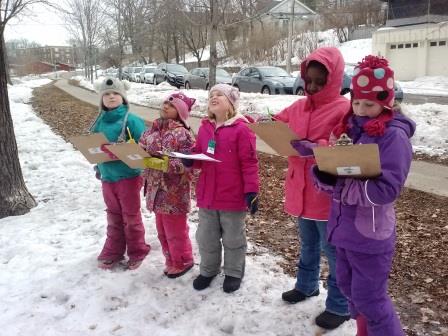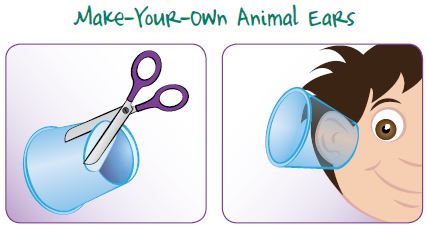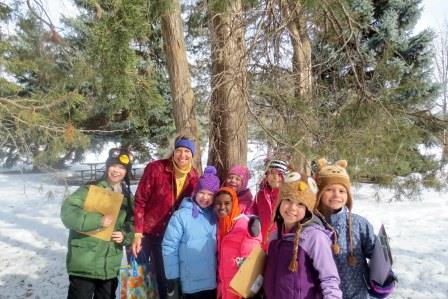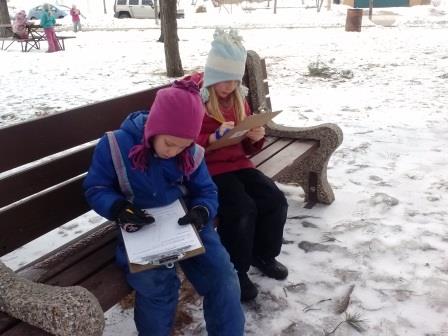 Crunch, chirp, buzzzzzz. Our city school yard is a veritable “nature orchestra!” Each season provides unique opportunities for young children to “tune in” to the sounds of our natural environment.
Crunch, chirp, buzzzzzz. Our city school yard is a veritable “nature orchestra!” Each season provides unique opportunities for young children to “tune in” to the sounds of our natural environment.
For example, where I teach in Minnesota:
- In the fall, we listen for the crunch of leaves and the honk of Canada geese winging southward;
- In the winter, we listen for the creak of tree branches and the scamper of the squirrels digging up their caches;
- In the spring, we listen for the tweet of the robin’s return and the plunk-plunk of melting snow;
- In summer, we listen for the whine of the mosquito and the rustling of the tall ostrich grasses.
PLT’s Sounds Around (Activity 2 in PLT’s Environmental Experiences for Early Childhood guide and Activity 4 in PLT’s PreK-8 Environmental Education Activity Guide) offers wonderful ideas for PreK-2 learners to explore sounds all around your neighborhood. Have students record, tally, and graph what they hear. If you have the opportunity to listen for sounds outside during different seasons, keep the charts and graphs so students can compare how sounds change from one season to the next.
 Setting the Stage
Setting the Stage
To prepare students for a walk outdoors that focuses on listening, first practice listening indoors. PLT’s Sounds Around activity suggests children mimic fox ears by cutting off the bottoms of paper cups and gently fitting the cups over their ears (see illustration). Children will learn that having ears on opposite sides of our head enables us (and other animals) to judge the location a sound comes from. Here are some modifications I use in my classroom.
- Jumbo Ears: Give each student a paper plate cut in half. Tell them these are jumbo “ears” for practicing “big listening.” On one paper plate ear, students write the word Nature. This is where we will record the sounds we hear made by things in nature: the wind, leaves, bees, etc. On the other paper plate ear, we write Humans and Machines. This is where we will draw sounds like a car starting, a door slamming, and a snow blower roaring.
- CD Tracks: Next we listen to a recording of neighborhood sounds. This can be a recording you have made from your local neighborhood or tracks 3 and 4 from PLT’s Environmental Experiences for Early Childhood CD. Have students draw what they hear on their jumbo ears.
- Tally Ho! Ask students to share which sounds they heard made by Nature and tally them on a large class chart. Follow suit with the sounds made by Humans and Machines. Compare the two lists. Finally, ask students to predict which types of sounds they think they will hear more on our walk outside.
Listening Walks
 Now it’s time to go outside for our first “listening walk”! For our Midwestern winters, mittens and layers are key. We walk quietly so we don’t scare away birds or other wildlife. We pick a spot a short distance away from the school building and sit or stand in a circle.
Now it’s time to go outside for our first “listening walk”! For our Midwestern winters, mittens and layers are key. We walk quietly so we don’t scare away birds or other wildlife. We pick a spot a short distance away from the school building and sit or stand in a circle.
- Hats and Headbands: I encourage students to pull their winter hats or headbands down to cover their eyes so they can really focus on what they hear. We listen quietly for about 3-5 minutes.
- Turn and Talk: Have students share what they heard with a partner.
- Math Connections: When we return to the classroom, we chart and graph how many different sounds we heard made by Nature and how many made by Humans and Machines.
Singing Songs
Try singing these songs with adapted lyrics to get children excited and focused on what they might hear or what they actually heard on our outdoor hike. Print these lyrics and slip them into plastic page protectors for convenient posting in the classroom or for carrying outdoors.
- “Here We Go on A Nature Adventure” Song: Sung to the tune of “Here We Go ‘Round the Mulberry Bush, ” this song helps students anticipate listening for sounds as we walk to our outdoor meeting spot. Encourage learners to look and listen and use this T-chart to record which living and nonliving things they see and hear outside.
- “In the Forest” Song: After our listening exercise, we gather to share our findings. Students compose their own lyrics for this song by inserting the sounds they heard. “In the Forest” is sung to the tune of “Are You Sleeping.”
Additional Resources on PLT.org
 The PLT website contains a wealth of resources to support PLT’s Sounds Around activity. Log in to access them. Here are some examples:
The PLT website contains a wealth of resources to support PLT’s Sounds Around activity. Log in to access them. Here are some examples:
- Before heading outdoors, teach children some American Sign Language (ASL) for some of the sounds they are likely to encounter.
- “Making Animal Ears”
- Literature connections
- Things for children to do together with family and friends
Happy listening!
Photo 1: Students listen for sounds of nature and record what they hear.
Photo 2: Teacher Karen Christenson with Saint Paul Public School students on a listening walk in winter.
Photo 3: Students participate in PLT’s Sounds Around activity.


